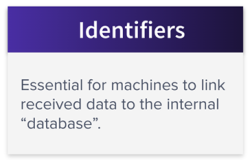Main Page: Difference between revisions
| Line 14: | Line 14: | ||
|} | |} | ||
Links: [[Layer_-_Identifiers|Identifiers]] | |||
The challenge in this approach is that the world is big, so there are many standards, for different territories, industries and use cases. Which has resulted in the fact that data exchange is still a technical and organizational nightmare. Example: A Food manufacturer sourcing raw materials and components from multiple suppliers and selling both A-Brand and Private Label products can be dealing with dozens of different ways to exchange origin and allergen data. While the type of data is 100% the same in all situations: Allergens information has the same data points for raw materials, production materials, semifinished goods and finished goods, and allergen data is not different for A-Brands or Private label brands. But still, from a technical standpoint, organizations need to deal with many ways to export or import allergen related data. | The challenge in this approach is that the world is big, so there are many standards, for different territories, industries and use cases. Which has resulted in the fact that data exchange is still a technical and organizational nightmare. Example: A Food manufacturer sourcing raw materials and components from multiple suppliers and selling both A-Brand and Private Label products can be dealing with dozens of different ways to exchange origin and allergen data. While the type of data is 100% the same in all situations: Allergens information has the same data points for raw materials, production materials, semifinished goods and finished goods, and allergen data is not different for A-Brands or Private label brands. But still, from a technical standpoint, organizations need to deal with many ways to export or import allergen related data. | ||
Revision as of 11:04, 27 February 2023
What is IMDE?
Interoperable Modular Data Exchange (IMDE) is a framework that will enable machine-2-machine exchange data across the entire value network. Minimizing the cost for collecting, using and distributing data. IMDE can overcome a number of the challenges faced by organizations, solution providers and data processors like datapools in terms of improving simplification of data exchange while at the same time improving data quality (consistency, relevance, completeness, accuracy and timeliness). The biggest benefits are in exchanging data with both upstream and downstream business partners. The beneficiaries are machines!, so not humans. The whole framework is designed for fully autonomous communication between machines.
Why Interoperable and Modular?
Many of the initiatives in the past focussed on creating standards for specific use cases, or in specific industries. These standards often covered all six layers of data exchange:
 |

|

| |
 |

|

|
Links: Identifiers
The challenge in this approach is that the world is big, so there are many standards, for different territories, industries and use cases. Which has resulted in the fact that data exchange is still a technical and organizational nightmare. Example: A Food manufacturer sourcing raw materials and components from multiple suppliers and selling both A-Brand and Private Label products can be dealing with dozens of different ways to exchange origin and allergen data. While the type of data is 100% the same in all situations: Allergens information has the same data points for raw materials, production materials, semifinished goods and finished goods, and allergen data is not different for A-Brands or Private label brands. But still, from a technical standpoint, organizations need to deal with many ways to export or import allergen related data.
The solution is to move away from all-in-one standards, where all standards had the strategy to become THE standard. And where every standard covers all 6 layers: the dictionary, the information model, the message structure, the exchange technology, the identifiers and the code lists. This new approach is based on the idea of allowing modular standards with independent solutions for all 6 layers. Also supporting/allowing multiple standard per layer. For example:
- Support data exchange using either an Excel file or an XML message.
- Exchange technology: Indirect via and or more data pools or direct via a RestAPI.
The key principle is to model for multiple interoperable modular standards in any part of the framework. In this way, industries, organizations and solutions providers can choose the standard per part of the data exchange that suits best.